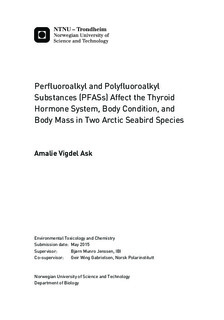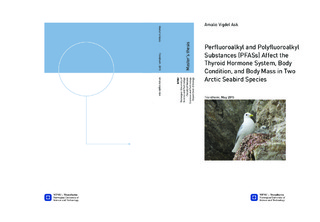| dc.description.abstract | Perfluoroalkyl and polyfluoroalkyl substances (PFASs) are being transported into the Arctic where they are frequently detected in wildlife. These compounds are suspected thyroid hormone (TH) disruptors due to their structural similarity to triiodothyronine (T3) and thyroxine (T4), in addition to their propensity to bind to proteins. Therefore, PFASs may affect THs by competitive binding to the thyroid binding proteins in the blood. The aim of the study was to investigate the concentrations of PFASs and THs, and examine effects of PFASs on THs, body condition, and body mass in black-legged kittiwakes (Rissa tridactyla) and arctic skuas (Stercorarius parasiticus).
Blood was collected from breeding black-legged kittiwakes and arctic skuas. Black-legged kittiwakes (hereafter kittiwakes) were sampled in Kongsfjorden, Svalbard in 2013 and 2014. Arctic skuas were sampled on Brensholmen, Norway and in Kongsfjorden in 2014. The blood was analyzed for perfluorohexanoate (PFHxA), perfluoroheptanoate (PFHpA), perfluorooctanoate (PFOA), perfluorononanoate (PFNA), perfluorodecanoate (PFDA), perfluoroundecanoate (PFUnDA), perfluorododecanoate (PFDoDA), perfluorotridecanoate (PFTrDA), perfluorotetradecanoate (PFTeDA), perfluorohexane sulfonate anion (PFHxS), branched and linear perfluorooctane sulfonate anion (brPFOS and linPFOS), perfluorodecane sulfonate anion (PFDS), and perfluorooctane sulfonamide (FOSA). The analyses were performed on plasma samples for the black-legged kittiwakes and on whole blood samples for the arctic skuas. PFHxA, PFHpA, PFOA, PFDS, and PFHxS were not detected in either bird species. Furthermore, total THs (TT3 and TT4) were quantified from plasma samples in both species. The resulting data was analyzed statistically to examine if there were associations between PFASs, THs, body condition (BC), and body mass.
The dominant PFASs in both kittiwakes and arctic skuas were linPFOS and PFUnDA. In both species, males generally had significantly higher concentrations of PFASs than the females. Furthermore, positive correlations between PFASs and THs were identified in both kittiwakes and arctic skuas. Male kittiwakes with high levels of PFDoDA, PFTrDA, and PFTeDA were in a better body condition than males with lower levels. Conversely, in female kittiwakes and male arctic skuas PFASs were negatively correlated to BC and body mass. The results indicate that PFASs affect the thyroid system, BC, and body mass in the two seabird species. | |

